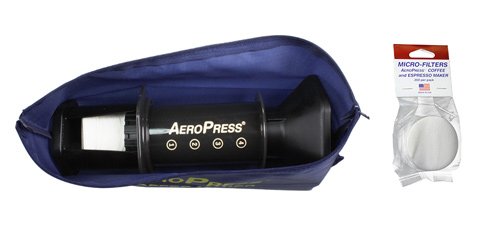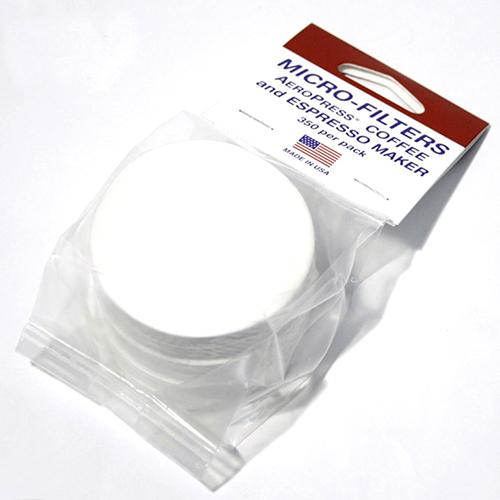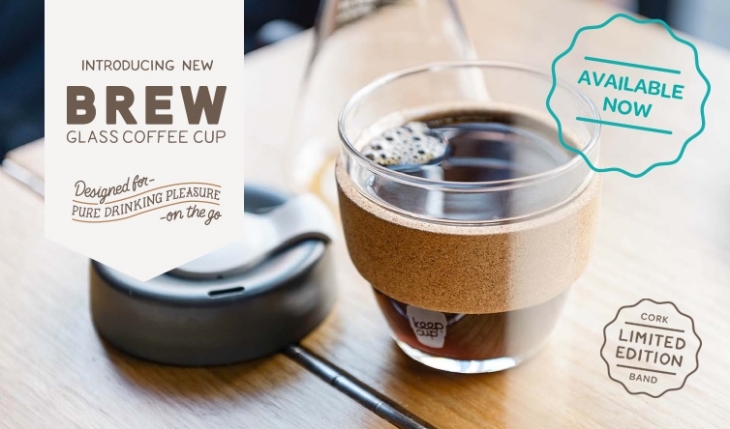Product Information
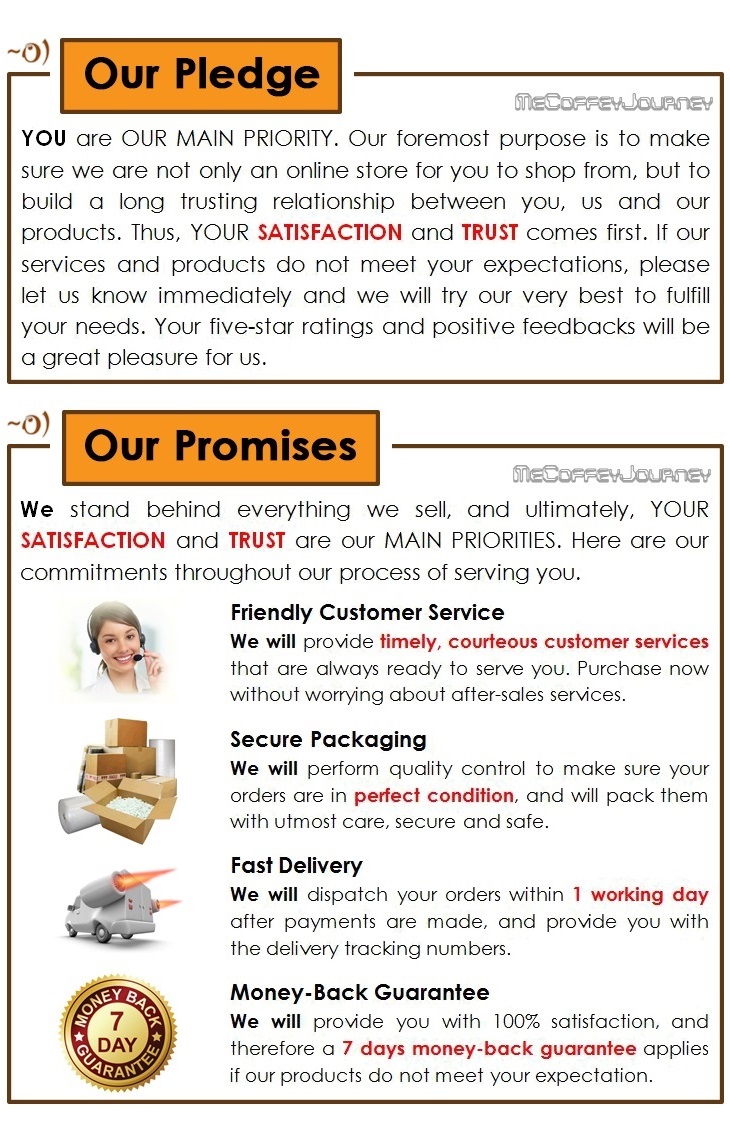
The AEROPRESS® is an entirely new way to make coffee.
- Water and grounds are mixed together for ten seconds.
- Then gentle air pressure pushes the mix through a micro-filter in 20 seconds.
- The total brewing time of only 30 seconds results in exceptionally smooth flavor.
- Tasters ranging from professional cuppers and author Kenneth Davids, to coffee aficionados all praise the smooth, rich flavor.
The brilliant, lightweight and portable AEROPRESS Coffee Maker produces quick, simple and delicious coffee in just 30 seconds. Increasingly popular with coffee aficionados, it can easily be dropped into a rucksack for a coffee-fuelled outdoor adventure and it’s a must-have for all camping situations. What’s more, at just RM 202.00, the coffee it produces can easily compete with coffee from machines costing thousands of Malaysian Ringgits.
- Plunger (with included seal)
- Chamber
- Seal
- Filter cap
- Funnel
- Filter holder and 350 micro-filters
- Coffee bean scoop
- Stirrer / stirring paddle

There are several reasons why AEROPRESS coffee tastes so good:
FULL IMMERSION METHOD
- Total immersion of the grounds in the water results in rapid yet robust extraction of flavor.
- Total immersion permits extraction at a moderate temperature, resulting in a smoother brew.
GENTLE AIR PRESSURE BREWING
- Air pressure shortens filtering time to 20 seconds. This avoids the bitterness of long processes such as drip brewing.
- The air pressure also gently squeezes the last goodness from the grounds, further enriching the flavor.
LOW ACIDITY
- Because of the lower temperature and short brew time, the acid level of the brew is much lower than conventional brewers.
- Laboratory pH testing measured AEROPRESS brew's acid as less than one fifth that of regular drip brew.
- The low acid is confirmed by coffee lovers who report that AEROPRESS brew is friendlier to their stomachs.
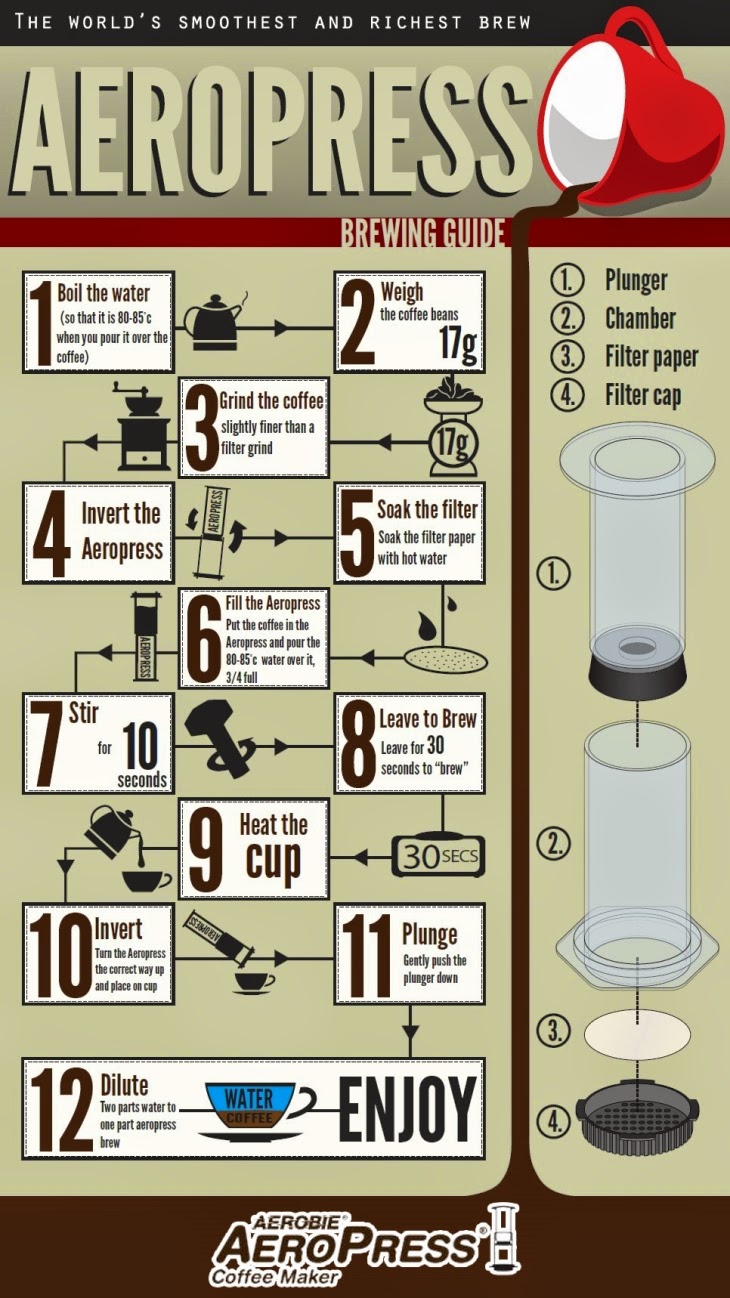
Comparison of brewing method:
DRIP BREWING
Drip brewing passes water through a bed of grounds. When the water first drips into the bed, it is too hot and bitterness is extracted. As the water filters downward through the bed, it becomes too cool and extraction is weak.
The water doesn't contact all of the grounds uniformly. Grounds at the edge of the bed are under-extracted, while grounds at the center are over- extracted and contribute bitterness.
Total immersion of the grounds in the AEROPRESS completely solves these problems. All of the grounds contact the same water temperature, and the brewing process is short and sweet. The gentle air pressure of the AEROPRESS also extracts extra flavor from the coffee. Ordinary drip brewers leave a lot of flavor in their soggy grounds.
The drip method cannot make a robust single cup because the small amount of water doesn't heat the bed enough for rich extraction. It is also slow. AEROPRESS makes one to four servings with a single pressing in less than a minute. The flavor is equally rich for any number of cups.
The lengthy wet time of drip brewing also extracts bitterness from the grounds.
In their 2005 edition of America's Test Kitchen Live, the editors of Cook's Illustrated Magazine wrote:
"Drip coffee machines make coffee easily, but rarely well -- often producing a burnt and bitter liquid reminiscent of stale truck stop coffee".
Finally, drip brewers cannot make espresso or lattes.
ESPRESSO MACHINES
Most coffee lovers agree that espresso is less bitter than drip brew because of the shorter brewing time. However when we ran comparison taste-tests in the homes of espresso lovers, they all agreed that AEROPRESS espresso tasted better than the brew from their high-priced European espresso machines -- why? The reason is that the total immersion brewing of the AEROPRESS yields a robust flavor at lower temperature -- and lower temperature brew is far less bitter. Home espresso machines don’tallow adjustment of temperature. But even if they did, their lack of total immersion would not yield robust flavor at reduced temperature.
In addition to smoother taste, the AEROPRESS has several other advantages over conventional espresso machines.
- Grind is not critical in the AEROPRESS. Grind is so critical in espresso machines that most grinders cannot produce a grind fine enough to make a good tasting shot! Special espresso grinders cost hundreds of dollars and require frequent cleaning.
- Espresso experts always adjust the grind when there are changes in humidity or batches of coffee. They throw away two or three shots while adjusting the grind in to achieve the desired 25-second shot.
- There is no tamping in the AEROPRESS. Books on espresso teach the art of just the right amount of tamping. They instruct the home barista to practice on the bathroom scale to learn exactly thirty pounds of pressure.
- There is no pre-warming of the portafilter head. In fact the AEROPRESS has no portafilter head!
- There is no maintenance. Espresso machines require regular cleaning and descaling with caustic chemicals. They also require disassembly and cleaning of the showerhead.
- There is no need to judge when to stop the pull. This is the most critical skill in using an espresso machine. As espresso lovers well know, most would-be baristas in coffee shops, hotels and restaurants run the pump too long -- extracting sour bitterness from the grounds.
- With the AeroPress, the amount of water is predetermined by the user, who can brew any strength from weak to super-intense just by choosing the desired amount of water prior to pressing.
POD BREWERS
Many single-cup pod brewers have come to market recently. Some of these machines make American coffee. Others make espresso. They range in price from about $60 to several hundred dollars. A highly respected product review magazine tested the three most popular pod brewers and reported the flavor as "mediocre at best."
There are also many negative reviews on internet discussion groups. For example two reviews of American-cup pod brewers at coffee forums.com:
"I tried everything I could to like the taste of the coffee, but I couldn't".
"I'm still not liking my own coffee made in this machine. So far it tastes awful".
FRENCH PRESS
People see some similarities between the AEROPRESS and a French Press. Both use total immersion and pressure. But the similarities end there.
The filter in the French Press is at the top of the mixture. Because coffee floats, the floating grounds clog the filter and makes pressing and cleaning very difficult. Users are instructed to use only coarse ground coffee. But this reduces the amount of flavor that can be extracted from the coffee and necessitates long steeping times which extract bitterness.
Furthermore, even coarse ground coffee includes many fine particles. These small particles pass through and around the filter resulting in a bitter, gritty brew. The particles in the brew continue to leach out bitterness. Consequently French press users are advised to drink or decant the brew immediately. Also, some particles clog the filter screen making pressing and cleaning very difficult.
AEROPRESS coffee is micro-filtered. It so pure and particle-free that it can be stored for days as a concentrate. The concentrate can be drunk as espresso, mixed with milk for lattes, or diluted to make American coffee. French presses cannot make espresso or lattes.
Finally, cleaning the French press is quite a chore. The AEROPRESS chamber is self-cleaning. A ten-second rinse of the plunger is all that's required.
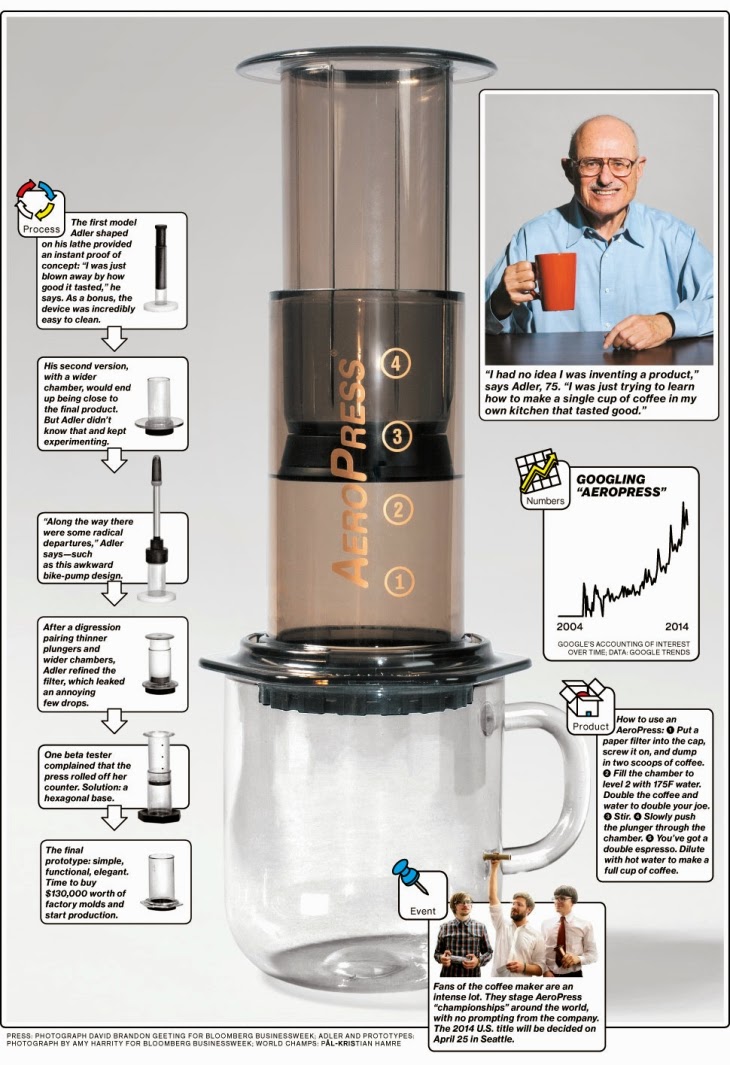
FREQUENTLY ASKED QUESTIONS
Won’t the AeroPress’ paper filter remove important oils that contribute to flavor that pass through the metal filters in my French press and my espresso machine?
We conducted blind-tasting tests with espresso and French press coffee lovers. They tasted paper-filtered AeroPress brew and metal-filtered brew – made with espresso filters and custom filters which were about three times finer. Every single taster preferred the paper-filtered brew.
This is not surprising, in light of the fact that the fine particles which pass through metal filters are quite bitter.
In the book Coffee - A Guide to Buying Brewing and Enjoying, renowned coffee author Kenneth Davids wrote about making drip coffee with metal filters;
“…you may not like coffee made with these filters as much as you like coffee brewed with paper filters. The mesh allows a good deal of sediment and colloids to enter the brewed coffee, which gives it a heavy, often gritty taste, closer in style to French-press coffee.”
Also, from the same book and page;
“A note on Filter Papers
Virtually all white filter papers manufactured today are whitened without use of dioxin, a carcinogen that was used in bleaching paper through the late 1980’s. For this reason, I feel confident in recommending white papers in preference to brown, which imparts a cardboardy taste to the brewed water and which may harbor some dubious chemicals of their own, including tars.”
Coffee made in my AeroPress is so smooth it seems weak. What am I doing wrong?
There are three possible answers to this question.
- The grind was not fine enough. A finer grind will yield a richer brew. If you are using a blade grinder, be sure to run it for 20 to 30 seconds. If you are using a burr grinder or having your coffee ground at the store, set the grinder midway between drip and espresso grind.
- You are not using enough coffee. Use the AeroPress scoop which is sized to optimize flavor.
- You are accustomed to coffee with a bite (the bitterness) and the smoother brew from an AeroPress without the bite seems weaker.
We have learned that many AeroPress users enjoy their coffee stronger now that they can brew it without the bitterness and with lower acidity. If you wish to try stronger coffee, just increase the amount of coffee used or reduce the amount of hot water used to dilute an espresso to an American cup.
I have a whirling blade grinder. Do I need to buy a more expensive grinder capable of a finer grind to fully enjoy coffee made in my AeroPress?
We've tested a number of these grinders and find that they work quite well but need to run a bit longer than their instructions suggest. Try about 30 seconds for two scoops. When the grind is fine enough for rich flavor it will tend to stick in the grinder because of static and you may have to help it out with a spoon.
Two scoops of a nice grind require about 20 to 30 seconds press time in the AeroPress. Coarser grinds will run through faster and make a slightly weaker cup.
To make a regular American cup of coffee using an AeroPress, you basically brew an espresso and then dilute it with hot water. Why not run a whole cup of water through the press?
We tried just that. But again, in blind-tasting tests everyone said that the coffee tasted smoother when made by our recommended method. Pushing too much water through the coffee extracts bitterness.
The instructions for the AeroPress recommend using 175° F (80°C) water. That doesn’t seem hot enough. Why don’t you recommend a temperature closer to boiling?
In developing the AeroPress we spent more time on taste-testing various brewing temperatures than on any other tests. Our tasters ranged from casual coffee drinkers, to coffee aficionados, to professional coffee tasters and consultants. Every single taster preferred brew made at 165° F to 175° F. They said the hotter brews were ok, but the 165° F to 175° F (74° C to 80° C) brews tasted best.
Books often recommend a brewing temperature of 195° F to 200° F (91° C to 93° C). This is good for conventional brewing methods that pass hot water through a bed of coffee. In this method, the water rapidly cools so the lower part of the bed is operating at a lower temperature. However in the AeroPress all of the coffee particles contact the same water temperature during the stirring phase.
Don’t worry about your coffee being too cool. About the hottest anyone drinks coffee is 145° F (63° C).
Why did you include a stirrer with the AeroPress? Almost any spoon will work.
The handle on the AeroPress paddle prevents the tip from tearing the paper filter. It also won’t scratch the AeroPress chamber.
Where can I buy more filters?
Each AeroPress comes with 350 filters so you have enough filters to last many months. Replacement packs of 350 filters are available from many of the retailers selling the AeroPress coffee maker.
How can I make it easier to press?
There are two possible answers to this question.
I have a whirling blade grinder. Do I need to buy a more expensive grinder capable of a finer grind to fully enjoy coffee made in my AeroPress?
We've tested a number of these grinders and find that they work quite well but need to run a bit longer than their instructions suggest. Try about 30 seconds for two scoops. When the grind is fine enough for rich flavor it will tend to stick in the grinder because of static and you may have to help it out with a spoon.
Two scoops of a nice grind require about 20 to 30 seconds press time in the AeroPress. Coarser grinds will run through faster and make a slightly weaker cup.
To make a regular American cup of coffee using an AeroPress, you basically brew an espresso and then dilute it with hot water. Why not run a whole cup of water through the press?
We tried just that. But again, in blind-tasting tests everyone said that the coffee tasted smoother when made by our recommended method. Pushing too much water through the coffee extracts bitterness.
The instructions for the AeroPress recommend using 175° F (80°C) water. That doesn’t seem hot enough. Why don’t you recommend a temperature closer to boiling?
In developing the AeroPress we spent more time on taste-testing various brewing temperatures than on any other tests. Our tasters ranged from casual coffee drinkers, to coffee aficionados, to professional coffee tasters and consultants. Every single taster preferred brew made at 165° F to 175° F. They said the hotter brews were ok, but the 165° F to 175° F (74° C to 80° C) brews tasted best.
Books often recommend a brewing temperature of 195° F to 200° F (91° C to 93° C). This is good for conventional brewing methods that pass hot water through a bed of coffee. In this method, the water rapidly cools so the lower part of the bed is operating at a lower temperature. However in the AeroPress all of the coffee particles contact the same water temperature during the stirring phase.
Don’t worry about your coffee being too cool. About the hottest anyone drinks coffee is 145° F (63° C).
Why did you include a stirrer with the AeroPress? Almost any spoon will work.
The handle on the AeroPress paddle prevents the tip from tearing the paper filter. It also won’t scratch the AeroPress chamber.
Where can I buy more filters?
Each AeroPress comes with 350 filters so you have enough filters to last many months. Replacement packs of 350 filters are available from many of the retailers selling the AeroPress coffee maker.
How can I make it easier to press?
There are two possible answers to this question.
- People who find their AeroPress too difficult to press are usually just pressing too hard. When you start pressing, depress the plunger about half an inch (one centimeter) and hold it. Let the compressed air in the chamber work for you. Several seconds later, press the plunger a little deeper and hold again. Repeat until you hear air escaping from the chamber which indicates all the liquid has been filtered. Now pressing the plunger down to the "puck" of coffee will be easy.
- If pressing gently does not solve the problem, your grind is too fine or perhaps only some of your grind is too fine (powder in the grind). If you are using a blade grinder, run it a little shorter time. If you are using a burr grinder or having it ground at a store, adjust the grinder one setting coarser.
When I add water to three or four scoops, why does the mix swell up and overflow?
This occurs with three or four scoops of very freshly roasted coffee when you use water that is hotter than the recommended 175° F (80° C). Try 175° F (80° C) or even 185° F (85° C) water and the problem will disappear. If you prefer hotter water and the bite it will produce in your coffee, limit each pressing to three or even two scoops.
Do you have any tips for making water a particular desired temperature such as the recommended 175° F (80° C) temperature?
Yes, we have several suggested methods.
- The most commonly used and an easy method for heating water to a desired temperature is to use a microwave oven. Measure the amount of water needed into a cup or other vessel and then heat it in a microwave oven. Use a kitchen thermometer (commonly used when cooking meat) to determine the number of seconds required to heat the water to the desired temperature. (Do not put the thermometer in the microwave oven.) For subsequent heatings, there is no need for the thermometer. Just remember the number of seconds required in the microwave to reach the desired temperature for the right amount of water.
- Another method involves using a measured amount of boiling water and then adding enough cold tap water to bring the water temperature down to 175° F (80° C). Pour boiling water into a measuring cup and then add enough cold tap water to increase the total water by a third. For example, if you measure 1.5 cups of boiling water, add cold tap water to bring the total to 2 cups.
- Still another way is to fill your cold cup with boiling water and let it sit for about a minute. This will reduce the temperature of the water and have the added benefit of preheating your cup. Then pour the water you will be using for the pressing into the plunger. By this time, first the mug and then the plunger have removed enough heat from the water (You can verify this the first time with your kitchen thermometer.) that you can now pour the water from the plunger onto the coffee in the chamber. You can then press back into your mug to make an American cup of coffee or back into your emptied cup to make an espresso.
- Many home "instant hot water" systems deliver 175° F (80° C) water or can be adjusted to that temperature. If you have such a system, using an AeroPress is really simple.
- Some electric kettles heat very quickly and have an adjustable temperature dial. You can set the dial to your favorite temperature and you are ready to heat water.
Why are there holes in the side of the AeroPress filter cap?

Why the appearance of Aeropress has changed over time?
In July 2014, we switched to making the chamber and plunger out of polypropylene. This means that all of the AeroPress parts except the rubber like seal are now made of polypropylene. We made the change because tests indicated the polypropylene is more durable. We regret the polypropylene is less transparent but feel the additional durability is more important. The rubber like seal on the end of the plunger is made of a thermoplastic elastomer. Both materials are FDA approved for use in contact with food. Neither of the materials contain bisphenol-A (BPA) or any phthalates. Every material we have ever used for the AeroPress has been phthalate free.

Although we have kept the design and size of the AeroPress the same, we have changed the materials a couple of times. When we first began manufacturing the AeroPress in late 2005, we selected polycarbonate, a material with a bluish tinge. We were unaware of BPA when we chose this material. When we learned about BPA and the health concerns associated with it, we had the polycarbonate tested and found that although polycarbonate contains BPA, no BPA was leaching from the AeroPress into the brewed coffee. Even though no BPA was leaching from the polycarbonate, we switched to copolyester in August 2009 so that we could assure people that the AeroPress was BPA free. Initially the copolyester was crystal clear but we later added a smoky grey tint because our market research indicated that consumers liked the appearance. In July 2014, per the above paragraph, we switched to using polypropylene. We also recently changed the color and appearance of the lettering on the AeroPress, switching from blue to gold and including the word “AeroPress” on the chamber. This makes our brand more apparent and makes it easier to tell a real AeroPress from a counterfeit.
This may seem like a lot of changes but our goal has always been to manufacture the AeroPress using the best materials we can find. These changes reflect our ongoing effort to do just that.
![AEROBIE Aeropress Coffee and Espresso Maker [Made in USA]](images/system/lazyload.gif)
![AEROBIE Aeropress Coffee and Espresso Maker [Made in USA]](images/system/lazyload.gif)
Shipping Information
| Zone | Order Total (RM) | Delivery Fee (RM) |
|---|---|---|
| West Malaysia | Below 200.01 | 8.00 |
| Above 200.01 | FREE Shipping | |
| East Malaysia | Below 200.01 | 15.00 |
| Above 200.01 | FREE Shipping |



![AEROBIE Aeropress Coffee and Espresso Maker [Made in USA]](https://image.youbeli.com/screenshots/513699_942498.jpg)
![AEROBIE Aeropress Coffee and Espresso Maker [Made in USA]](https://image.youbeli.com/screenshots/513699_942499.jpg)
![AEROBIE Aeropress Coffee and Espresso Maker [Made in USA]](http://img.youtube.com/vi/HlJm1vKQX5Q/0.jpg)
![AEROBIE Aeropress Coffee and Espresso Maker [Made in USA]](http://img.youtube.com/vi/-caucoORs9g/0.jpg)

